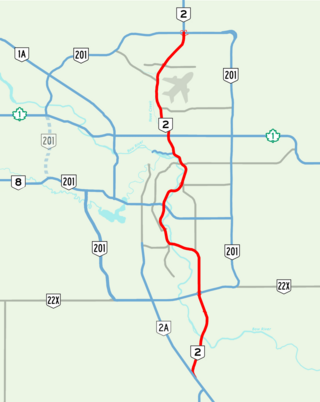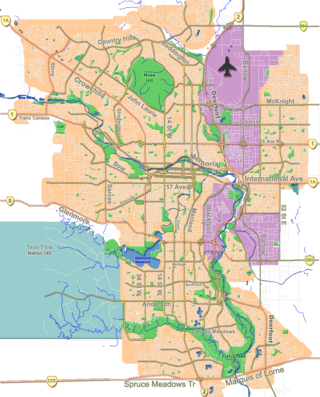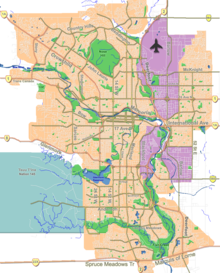
Deerfoot Trail is a 46.4-kilometre (28.8 mi) freeway segment of Highway 2 in Calgary, Alberta, Canada. It stretches the entire length of the city from south to north and links suburbs to downtown via Memorial Drive and 17 Avenue SE. The freeway begins south of Calgary where it splits from Macleod Trail, crosses the Bow River into city limits, and reaches the Stoney Trail ring road. Crisscrossing twice more with the river, it intersects Glenmore Trail and Memorial Drive; the former is a major east–west expressway while the latter is a freeway spur into downtown. In north Calgary, it crosses Highway 1 and passes Calgary International Airport before ending at a second interchange with Stoney Trail. Highway 2 becomes the Queen Elizabeth II Highway as it continues north into Rocky View County towards Red Deer and Edmonton.

The Calgary Public Library (CPL) is a distributed library system featuring 22 branch locations including the Central Library. As of 2012, it is the second most used system in Canada and the sixth most used library system in North America. This is despite the fact that the Calgary Public Library has one of the lowest per capita funding in the country, receiving as little as half the money of other Canadian public libraries.

Kensington is a Business Revitalization Zone (BRZ) in Calgary, Alberta, focused around the intersection of Kensington Road and 10th St. NW, also known as the Kensington-Louise Crossing Business Association. It is located in the communities of Hillhurst and Sunnyside, immediately north of downtown and the Bow River, and is easily reached by most of the city's major access routes.

Downtown Calgary is a dense urban district in central Calgary, Alberta. It contains the second largest concentration of head offices in Canada, despite only being the country's fourth largest city in terms of population. The downtown is divided into several residential, commercial, corporate, and mixed-use neighbourhoods, including the Financial District (CBD), Eau Claire, Chinatown, East Village, Beltline, and the West End.
Parkdale is a mature, inner city neighbourhood in the city of Calgary, Alberta along the north bank of the Bow River between the communities of West Hillhurst and Point McKay. It is bounded on the south by the Bow River, 28 St NW to the east, Shaganappi Trail NW to the west and on the north by 16th Avenue. Parkdale is in close proximity to both the Foothills Medical Centre and the Alberta Children's Hospital constructed in 2006, as well as the University of Calgary. Memorial Drive provides access to downtown Calgary and to Highway 1 which leads to the Rocky Mountains. Parkdale was annexed to the City of Calgary in 1910 when Calgary began to experience a "major economic and building boom." The boom ended in 1913 and further development of the Parkdale Addition as it was called, was halted because of World War I. Following World War II in the 1950s the dominant housing type that characterized Parkdale, was the bungalow. By 2014 Parkdale, like other inner city communities in Calgary, was experiencing gradual gentrification with small cottage-style bungalows being replaced by spacious flat roofed, Prairie School Frank Lloyd Wright inspired infills attracting young families with children away from the long commute suburbs to inner city ease of access to downtown, transit and work.
Pineridge is a neighbourhood in Northeast Calgary, Alberta, Canada, and is one of four neighbourhoods that make up what is called the Properties, along with Whitehorn, Temple, and Rundle. It is bordered by 32 Ave NE to the north, 52nd Street NE to the west, 16th Avenue NE to the south, and 68th Street NE to the east.
Crowchild Trail is a major expressway in western Calgary, Alberta. The segment from the 12 Mile Coulee Road at the edge of the city to 16 Avenue NW is designated as Highway 1A by Alberta Transportation. The road is a critical north–south link in West Calgary for both downtown-bound traffic and travel between the two quadrants of the city it passes through. Although planned to be one single freeway from Glenmore Trail to the city limits, the route is divided by a section of slow-moving arterial road with four signalized intersections between 24 Avenue and Memorial Drive. This separates the freeway in the northwest from the freeway south of the Bow River. Filling the gap and making the whole route a minimum six-lane freeway is planned for construction beyond 2027.
The city of Calgary, Alberta, has a large transportation network that encompasses a variety of road, rail, air, public transit, and pedestrian infrastructure. Calgary is also a major Canadian transportation centre and a central cargo hub for freight in and out of north-western North America. The city sits at the junction between the "Canamex" highway system and the Trans-Canada Highway.
West Hillhurst is a northwest neighbourhood lying within the inner suburbs of Calgary, Alberta, Canada. The community, which is located west of Hillhurst, is bisected by Crowchild Trail. On the north, West Hillhurst is bordered by the communities of Hounsfield Heights/Briar Hill and St. Andrews Heights. Other boundaries are 18th Street W to the east, the Bow River to the south and 28th Street W to the west.

Hillhurst is a community located within the inner city of Calgary, Alberta, Canada. The boundaries of the community are 8th Avenue NW to the north, 10th Street NW to the east, the Bow River to the south, and 18th Street NW to the west. The communities of Hillhurst and the neighbouring Sunnyside together form the Hillhurst-Sunnyside Community Association. The two communities have an area redevelopment plan in place, revised in 2009.
Acadia is a neighbourhood in the southeast quadrant of Calgary, Alberta. The area is bounded on the west by Macleod Trail, on the east by the Bow River, on the north by Heritage Drive and on the south by Southland Drive.

Memorial Drive is a major road in Calgary, Alberta. Aside from its important role in city infrastructure, the tree lined sides of Memorial Drive serve as a living testament to the many local soldiers who died during World War I and give it a parkway look on the western section. An active path system also runs along the south side of Memorial Drive, beside the banks of the Bow River. The Calgary Soldiers' Memorial forms part of an extensive renovation to Memorial Drive, which heightens the function of the road as a monument to the city's military. The Landscape of Memory Project began in 2004, in order to revitalize a nine kilometre stretch of the road. The design incorporated "Poppy Plaza" at the corner of Memorial Drive and 10th Street NW. The plaza used "weathered steel" to create large gateways, and the plaza and adjacent river walk were lined with the same rusted metal into which quotes about the Canadian experiences of war were cut. The Peace Bridge was incorporated into the remembrance theme of Memorial Drive, though there are no explanatory plaques at the site of the bridge.
Varsity is an established neighbourhood in the Northwest quadrant of Calgary, Alberta. It was developed in the 1960s and early 1970s on a plateau to the north of the Bow River valley, and is primarily composed of Single-detached dwellings on wide lots. The neighbourhood comprises three major areas: Varsity Acres, Varsity Village, and Varsity Estates. Varsity is bounded on the north and east by Crowchild Trail, on the west by the Bow River, and on the south by 32nd Avenue NW. It borders the neighbourhoods of Silver Springs and Bowness on the west side, and both Montgomery and the University of Calgary campus on the south side. The easternmost portion of Varsity contains the University of Calgary Research Park.
Crescent Heights is a neighbourhood located in Calgary, Alberta. It is located in the inner city, immediately north from Downtown. It is bounded to the north by the Trans-Canada Highway, on the east by Edmonton Trail, on the west by 4th Street NW, and to the south by Memorial Drive and the Bow River.

Prince's Island Park is an urban park in the city of Calgary, Alberta, Canada. It is developed on an island on the Bow River, immediately north of downtown Calgary.
Taradale is a residential neighbourhood in the northeast quadrant of Calgary, Alberta, Canada. It is located at the eastern edge of the city, and it is bounded to the north by Taradale Drive, to the east by 68 Street E, to the south by 64 Avenue N and to the west by Falconridge Boulevard.

Riley Park is an urban park in Calgary, Alberta, Canada. It is located in the neighbourhood of Hillhurst, bounded by 8th Ave. NW, 10th St. NW, 5th Ave. NW and 12th St. NW. The park is host to Calgary's cricket leagues, and the Calgary Concert Band holds free concerts in the park during summer. Amenities include a wading pool and playground.

Druh Farrell is a municipal politician who formerly served as Councillor for Ward 7 in Calgary, Alberta. She was first elected in 2001.

16 Avenue N is a major road in Calgary, Alberta, that forms a 26.5-kilometre (16.5 mi) segment of Highway 1 and connects Calgary to Banff and Medicine Hat. It is a four to six-lane principal arterial expressway at its extremities, but is an urban arterial road between the Bow River and Bowness Road, and also between Crowchild Trail and Deerfoot Trail. Due to Calgary's quadrant system, it is known as 16 Avenue NW west of Centre Street and 16 Avenue NE to the east.













